
Toshiba TR200 SSD Review: Toshiba's 3D BiCS Flash Technology Is Here
Introduction

In July, Toshiba introduced the TR200 SSD which features the company's 3-bit-per-cell TLC (triple-level cell) BiCS flash technology. This is Toshiba’s first SSD with 64-layer 3D flash memory and it's being targeted at PC gamers and users who are into building and upgrading their own computers. The last SSD from Toshiba was the VX500 which was well-received by the enthusiast community for being affordable while still offering excellent performance.
Toshiba's TR200 series range in capacities of 240GB, 480GB and 960GB, and is only available in a 2.5" form factor. The TR200 SSDs are available for purchase at $90 for the 240GB model, $150 for the 480GB model, and $290 for the 960GB version and come with a three-year limited warranty. Length of warranty is very important and a three-year warranty is considered short because Samsung offers a five-year warranty on their 850 EVO a ten-year warranty on their 850 PRO SSDs.
The Toshiba TR200 series is rated for sequential read speeds of up to 555 MB/s and sequential write speeds of up to 540 MB/s for all capacities. Now the random 4K write speeds for the 240GB model is rated at 87K IOPS while the 480GB and 960GB models are rated for 88K IOPS. Moving on to the random 4K read speeds, the 240GB model is rated for up to 79K IOPS, 480GB model for up to 82K IOPS, and 81K IOPS for the 960GB version.
The TR series are aimed toward budget users and to keep the cost low, Toshiba decided to use TLC NAND and a DRAM-less controller which normally means you are compromising on performance for affordability. To make up for that, the TR200 uses SLC Write Cache to boost write performance which is a fixed SLC cache size. Based on my calculations, the SLC write cache comes out to 4GB for the 240GB model, 8GB for the 480GB model and 16GB for the 960GB version. SLC Write Cache is designed to dramatically speed up write performance of SSDs based on MLC and TLC NAND flash memory by writing a single bit to each flash cell.
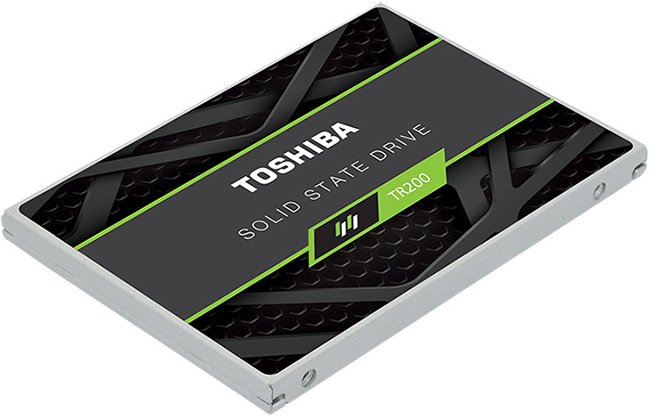
Toshiba's 3D BiCS NAND technology is built to endure 60TB (TBW) for the 240GB model while the 480GB model on the other hand can handle up to 120TB written (TBW) and the 960GB model up to 240TB (TBW). The 240GB's endurance equates to approximately 55GB daily read/write workload over a period of three years while the 480GB model equates to approximately 110GB daily read/write. The 960GB model comes out to 219GB daily read/write over three years which is also pretty good.
As far as the competition in the SSD market goes, Samsung has been dominating the SSD market with their 850 Pro and 850 EVO SSDs. Keep in mind that Samsung released the 850 Pro about three years ago and it was the first manufacturer to release SSDs with 3D Vertical NAND and the 850 Pro still remains the fastest consumer SATA SSD on the market. The 850 EVO is also a very popular SSD among gamers and enthusiasts and it comes with a max capacity of up to 4TB. The TR200 series on the other hand tops out at 1TB.
The TR200 supports many advance features such as garbage collection and TRIM. It's important to remember that for TRIM to work, the OS and the SSD must support the feature. The TR200 also supports Self Monitoring and Reporting Technology (SMART) which basically is a monitoring system used to perform an analysis of the drive for problems with the intent of anticipating hardware failures.
The Toshiba TR200 Supports The Following Features:
- Native Command Queuing (NCQ)
- Garbage Collection
- TRIM Support
- Self Monitoring and Reporting Technology (SMART)
- Error Correction Code (ECC)
- Device Sleep Extreme Low Power Mode (DevSleep)
Specifications
| Toshiba TR200 Series Lineup | |||
|---|---|---|---|
| Model: | TR200 240GB | TR200 480GB | TR200 960GB | Price: | $90 | $150 | $290 |
| Interface: | SATA III 6Gb/s | ||
| Form Factor: | 2.5" | ||
| Flash Technology: | 3D BiCS | ||
| Controller: | Toshiba TC58NC1010 (Phison S11) | ||
| DRAM: | None | ||
| NAND: | Toshiba 256Gb 64L BiCS3 3D TLC | Toshiba 512Gb 64L BiCS3 3D TLC | |
| Sequential Read: | 555 MB/s | ||
| Sequential Write: | 540 MB/s | ||
| Random Read: | 79K IOPS | 82K IOPS | 81K IOPS |
| Random Write: | 87K IOPS | 88K IOPS | |
| Endurance: | 60 TB TBW | 120 TB TBW | 240 TB TBW |
| Floating Gate: | 15nm | ||
| MTBF: | 1.5 Million Hours | ||
| Firmware: | SBFA12.0 | ||
| TRIM supported: | Yes | ||
| SLC Write Cache: | 4GB (?) | 8GB (?) | 16GB (?) |
| Encryption: | None | ||
| Warranty: | 3 Years | ||
| Launch Date: | July 2017 | ||
Packaging
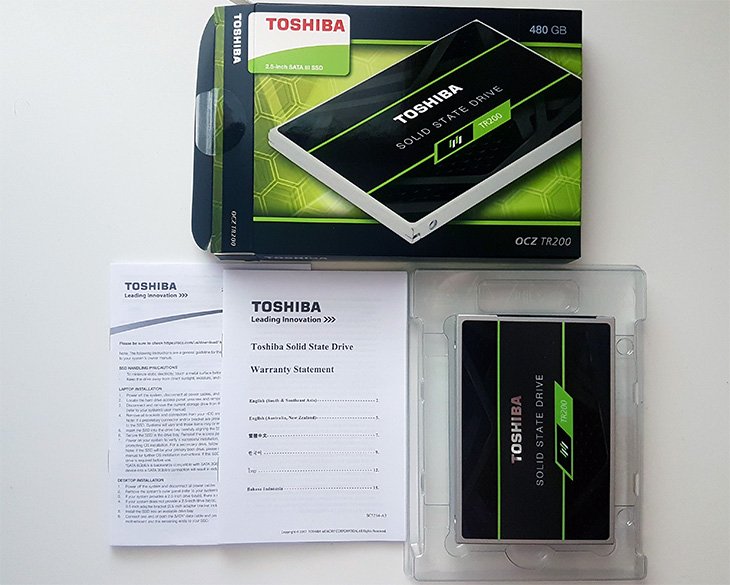
The Toshiba TR200 SSD comes in a silver aluminum enclosure and features the standard SATA III interface. Like most SSDs, the Toshiba TR200 utilizes the SATA III 6Gbps interface but it is compatible with SATA II and SATA I interfaces, but that means it will work at a reduced speed.
You can download the OCZ SSD Utility software which helps monitor and enhance the performance of your SSD and it also allows you to update the firmware, monitor, and secure-erase the SSD. You can also monitor your SSD’s temperature and health, benchmark and track how much storage you’ve used.
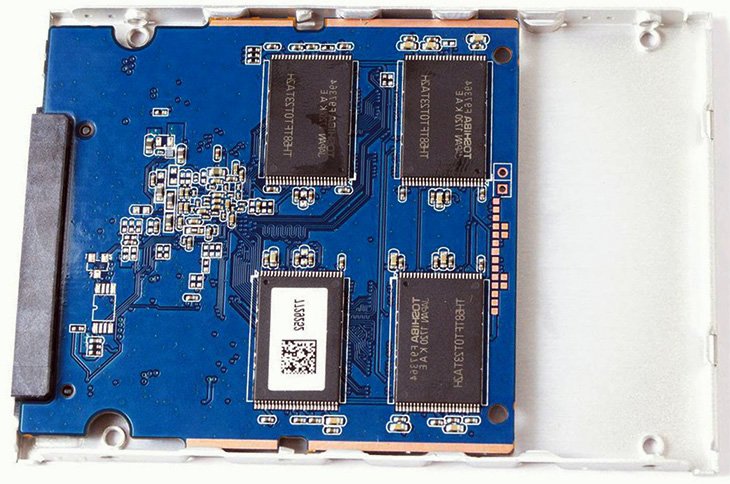
Once the SSD is opened, you will immediately notice how small the PCB is. On each side of the PCB you will find four NAND flash memory ICs which is Toshiba’s latest third generation 64-layer BiCS 3D flash. On the other side you will find the Toshiba TC58NC1010 2-channel DRAM-less controller.
Test Methodology
| Test Setup | |
|---|---|
| Processor: | AMD Ryzen 7 1700X (3.8Ghz) |
| Motherboard: | MSI X370 xPower Titanium (BIOS v1.9) |
| RAM: | Ballistix Elite 16GB (2x8GB) DDR4 3200 MHz |
| Graphics Card: | Nvidia GeForce GTX 1070 |
| Storage: | Toshiba TR200 480GB Crucial BX300 240GB Crucial BX300 480GB Crucial MX300 525GB Crucial MX300 1050GB Samsung 850 EVO 500GB Samsung 850 EVO 250GB Samsung 850 Pro 512GB |
| Power Supply: | SilverStone ST80F-TI (800W) |
| Heatsink: | Noctua NH-D15 |
| OS: | Windows 10 Home 64-Bit |
| Thermal Compound: | Noctua NT-H1 |
| Case: | Corsair 400C |
To make sure these drives perform at their maximum performance, we will be disabling all the power saving features in the BIOS (C6-state, etc). The testing was done on a fresh install of Windows 10 64-bit with the latest windows updates installed. We disabled a bunch of unnecessary services and removed all the bloatware from Windows 10 to make sure there were as few processes running as possible during the testing.
We'll be using the AMD Ryzen 7 1700X processor overclocked to 3.8Ghz and the MSI X370 xPower Titanium motherboard
with the latest BIOS version which at the time of writing this is v1.90.
Installing and using an SSD is pretty straight forward, simply connect one end of your SATA cable to the SATA port in your motherboard and the other end of the cable to your SSD.
After installing windows, make sure to check if you have the latest firmware.
Benchmark Software:
+ Windows 10 Startup
+ Adobe PS CS6 Startup
+ AS SSD
+ IOMeter
+ HD Tune Pro
+ ISO File Copy
Benchmark Results
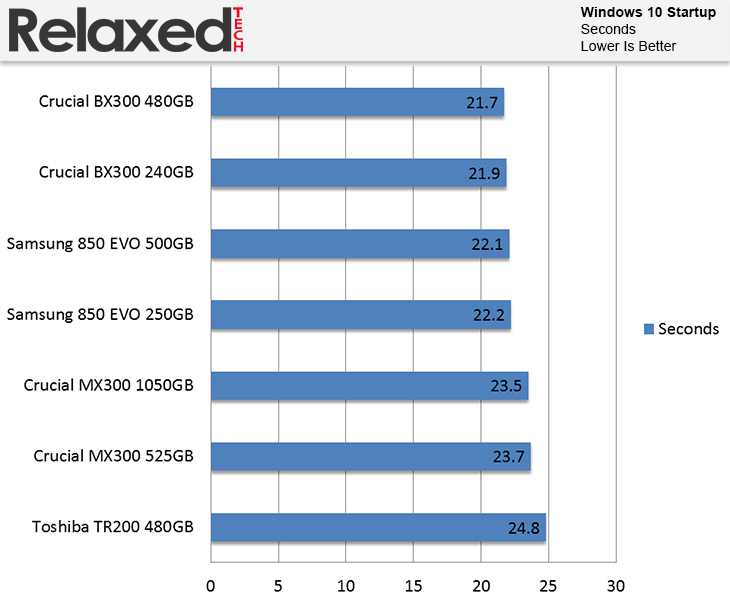
Windows 10 boot times are measured from the time it takes between hitting the power button to reaching the Windows desktop.
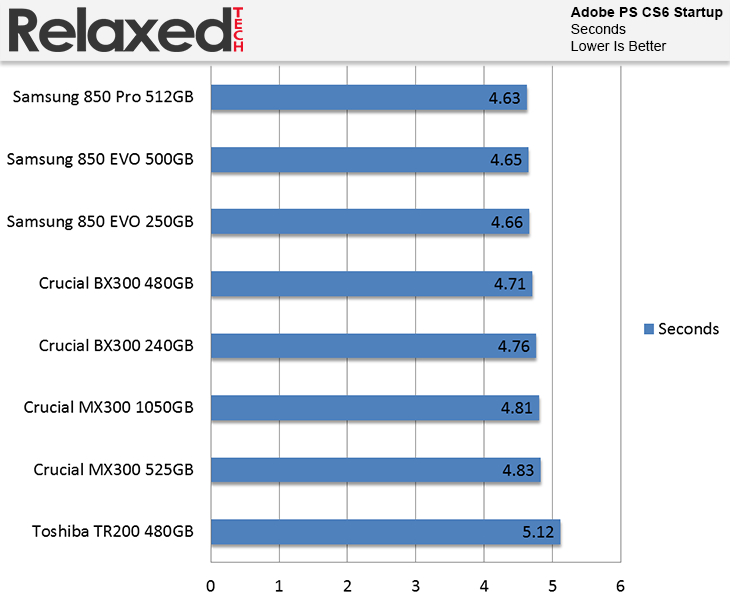
Startup times for Adobe Photoshop CS6 are measured from the moment it takes to open up the application.
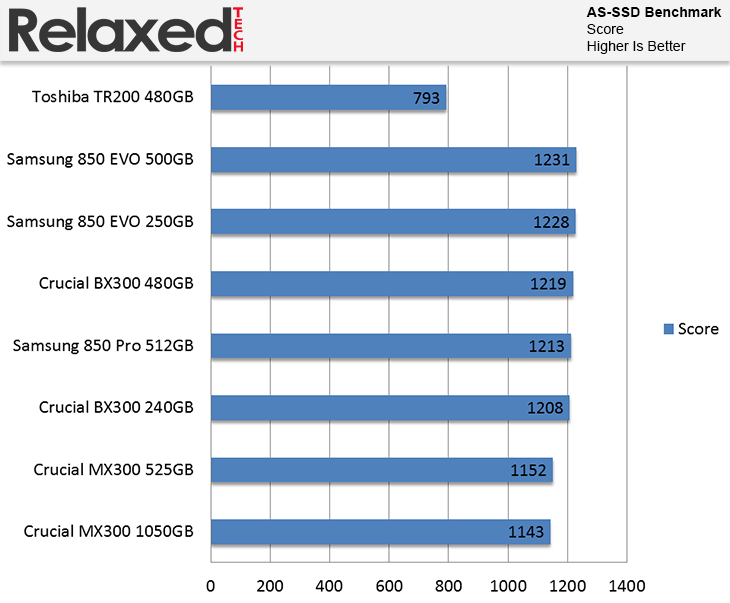
The AS-SSD software is a popular benchmarking software used to measure the performance of an SSD. In this test we are measuring the overall score.
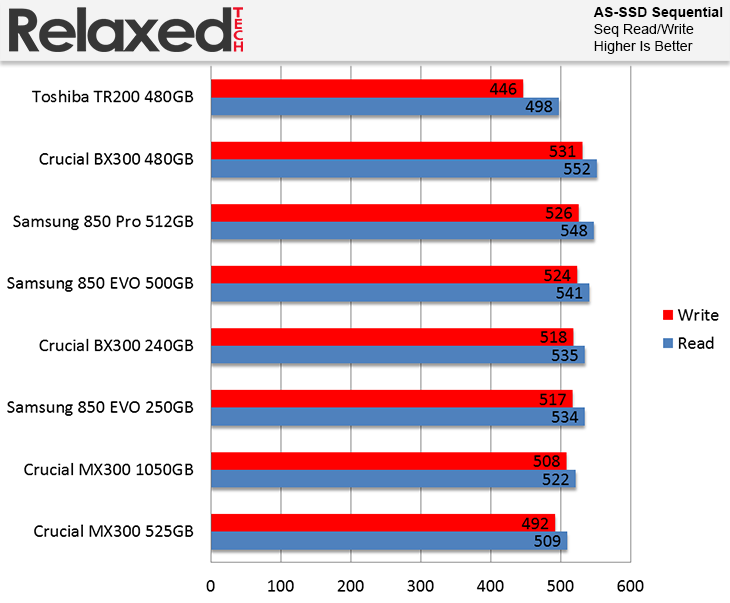
Once again, we are using the AS-SSD software to measure sequential read and write speed of each drive.
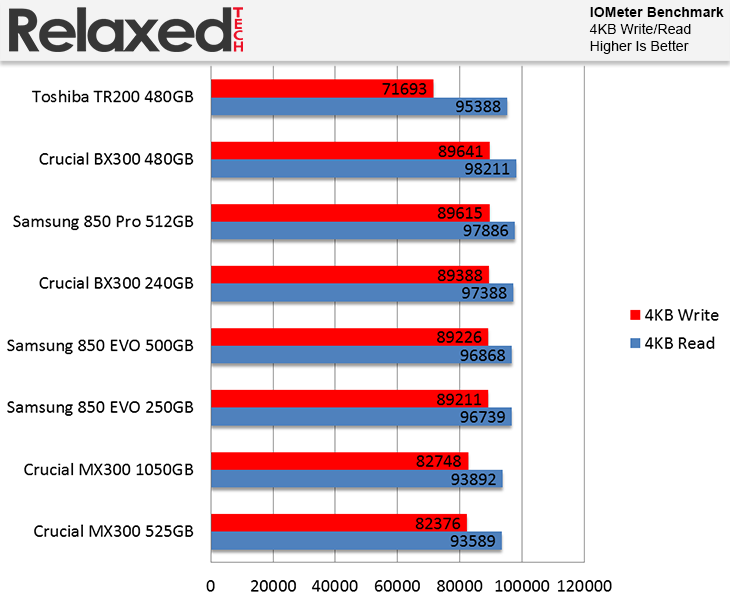
In this test, we are using IOMeter which is one of the best application for stress testing the random IO performance of an SSD. IOMeter is set to use 4KB file size chunks and will stress the SSD with random 4 KB files.
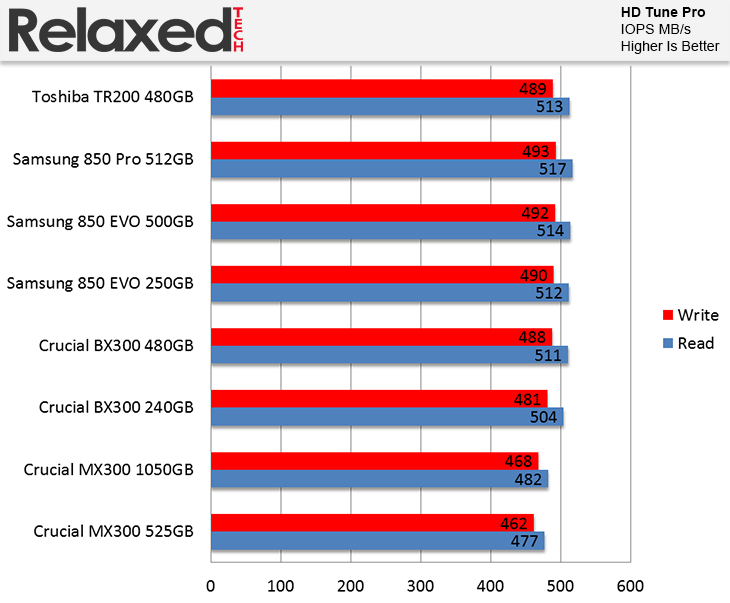
Here we are using HD Tune Pro to measure read and write IOPS. HD Tune Pro is a Hard Disk Utility with many functions such as error checking, S.M.A.R.T and benchmarking.
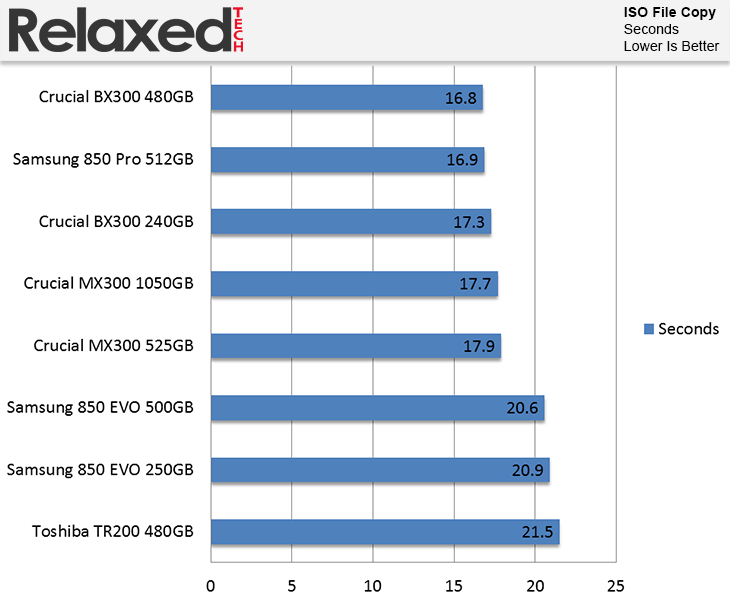
To represent a large file usage scenario, we are copying a 5GB ISO image to a different folder on the same drive.
Conclusion
The Toshiba TR200 480GB is a good entry level SSD and offers good performance for its price. From a price/performance perspective, the TR200 series are around $10-15 cheaper than the 850 EVO depending on where you live. The 480GB model we tested suffers from low 4K write speeds but overall, it offers good performance.
Toshiba has said that the TR200 series will be the only new SATA based drive series in 2017
and they seem committed to releasing NVMe SSDs in the future in all market segments.
If you are using a traditional hard drive, you might want to consider upgrading to an SSD like the TR200 because it will offer a massive
upgrade in every aspect from boot times to read/write speeds to access times.
Pros:
+ Good Performance
+ OCZ SSD Utility
+ Affordable
+ Good Packaging
Cons:
- Three Years Warranty
- 4K Write Performance
- Only 1TB Max Capacity Available
The only downside that I see with the TR200 480GB SSD, besides the poor 4K write performance, is the short three year warranty.
Samsung provides a 5-year warranty for their 850 EVO SSDs and 10-years for their 850 Pro SSDs.
Also, I hope that Toshiba releases a 2TB and 4TB model in the future to compete against the 850 EVO which is available in both 2TB and 4TB versions.
Toshiba's pricing of the TR200 series makes it quite affordable and it will probably go down a bit more once availability ramps up over the coming weeks. If you're looking to buy a reliable but also affordable SSD either for your laptop or desktop, the new Toshiba TR200 SSDs might be the SSD you need. Overall, I believe the Toshiba TR200 480GB SSD deserves our Great Value award.
Final Score 8.5
